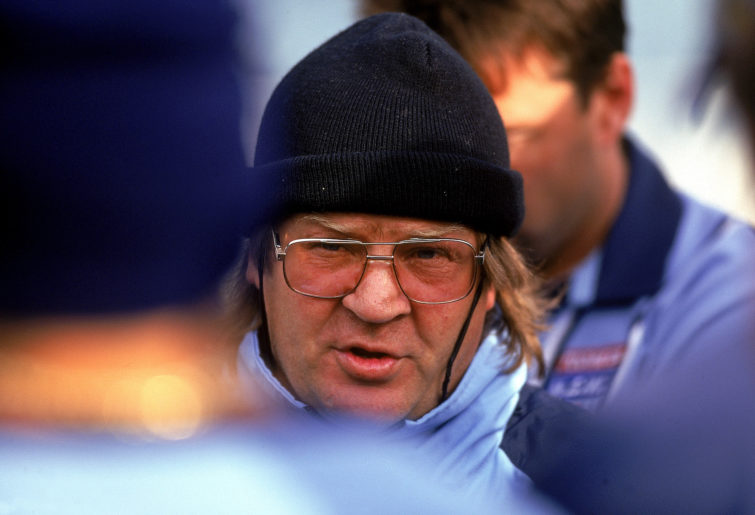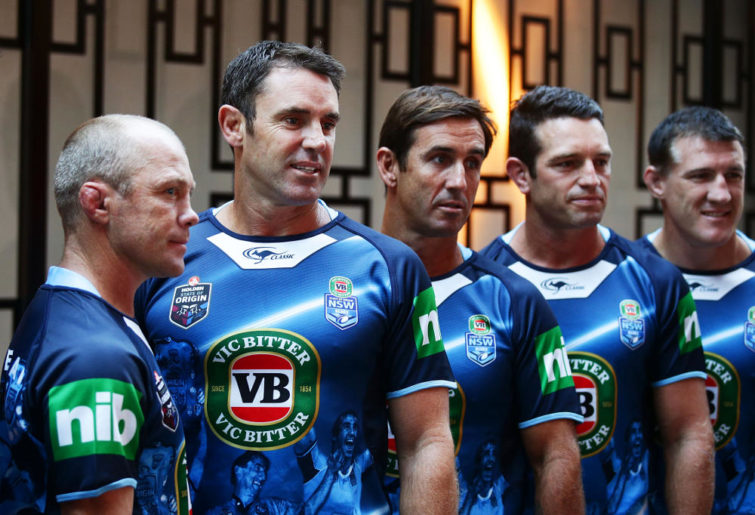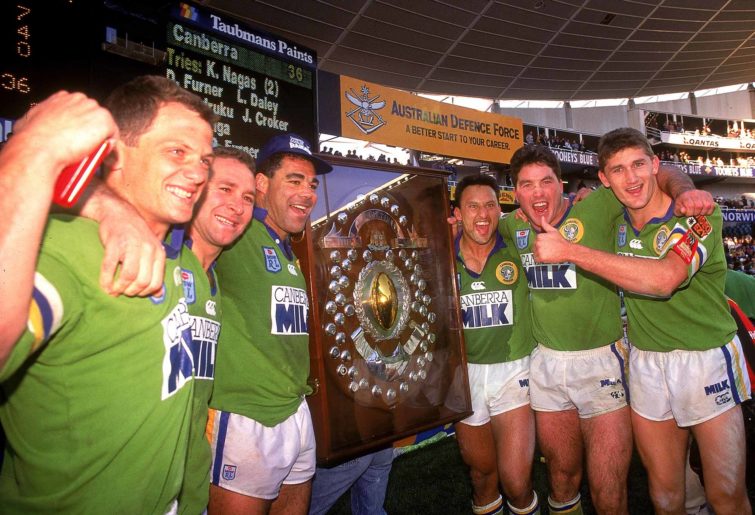1997 was the year that rugby league in Australia split into two.
On one side was the 12-team ARL competition, made up of the teams that stayed loyal to the traditional competition, including eventual grand finalists Manly and Newcastle.
On the other side stood the ten-team rebel Super League competition, made up of eight teams who split from the ARL, including grand finalists Brisbane and Cronulla, and two new teams, the Hunter Mariners and the Adelaide Rams.
Both competitions had their own version of the interstate series, with the ARL running the traditional State of Origin series between NSW and Queensland, while Super League came up with the Super League Tri-Series, contested by teams from NSW, Queensland and New Zealand. (New Zealand? That’s in Queensland isn’t it?)
In the ARL series, coach Tom Raudonikis got his NSW team home by the narrowest of margins to take the series two games to one, with Queensland, coached by Paul Vautin, actually outscoring NSW by 38 points to 35 across the series.

(Photo by Sean Garnsworthy/Getty Images)
In the Super League Tri-Series, NZ didn’t win a game in the preliminary round, leading to a NSW versus Queensland final. NSW, coached by Tim Sheens, defeated Wayne Bennett’s Queensland team by a golden point field goal in the 104th minute of the game after the teams couldn’t be separated in either normal time or 20 minutes of extra time.
So it was a great year for NSW on the representative front, but the question is which NSW team was stronger? The ARL’s team or the Super League team?
To help decide the issue, albeit now a quarter of a century late, let’s use my simplistic rating system to compare the NSW teams that played in each series, in order to determine which one was the most dominant, and accordingly more likely to win.
Note: my verdict names who I believe is the dominant player, and the +1 or +2 rating refers to their level of dominance: +1 for dominant, and +2 for very dominant. Players shown are those who played most games for their respective teams in their positions.
1. David Peachey (SL) versus Tim Brasher (ARL)
David Peachey was a player on the rise in 1997 but probably still hadn’t reached his full potential.
Tim Brasher was the incumbent Australian fullback, had 14 Tests under his belt and hadn’t missed an Origin game for NSW since making his debut in the third game in 1992.
Verdict: Tim Brasher (ARL) +1
2. Ken Nagas (SL) versus Ken McGuinness (ARL)
Nagas was in career best form between 1994 and 1997 and his speed and power made him one of the most potent wingers in the game.
Ken McGuinness had one of his best seasons for the Magpies in 1997 but the only time he played wing was when selected there for NSW.
Verdict: Ken Nagas (SL) +1
3. Andrew Ettingshausen (SL) versus Terry Hill (ARL)
Ettingshausen had been one of the best outside backs in the game for a long time, and although 31 years of age by the time 1997 Origin rolled around, still had the class, skill and speed to trouble any opponent.

(Photo by Getty Images)
Terry Hill was a very tough and experienced player at that stage of his career and often partnered Ettingshausen in the centres for NSW before Super League came along.
Verdict: Too close to call – a draw
4. Ryan Girdler (SL) versus Paul McGregor (ARL)
Girdler was a very enterprising player capable of beating opponents both on the inside and outside and would establish himself as one of the best centres in the game by the late ’90s.
Paul McGregor was both big and skilful, and had been a stalwart for both NSW and Australia since the early ’90s, but injuries saw him lose a yard of pace by the time this match was played.
Verdict: Too close to call – a draw
5. Brett Mullins (SL) versus Jamie Ainscough (ARL)
Brett Mullins was a freakish player with the pace and footwork to worry even the best defence, and he could score a try from anywhere on the field.
Ainscough was a solid rather than spectacular performer, who played some of his best football in the centres.
Verdict: Brett Mullins (SL) +1
6. Laurie Daley (SL) versus Jim Dymock (ARL)
Laurie Daley was one of the best players in the game in 1997 with a host of Test and Origin matches under his belt. He excelled in both attack and defence.
Jim Dymock was a clever footballer, known for his ball-playing skills, and was always probably a much better lock forward than five-eighth.
Verdict: Laurie Daley (SL) +2

(Photo by Matt King/Getty Images)
7. Noel Goldthorpe (SL) versus Geoff Toovey (ARL)
Goldthorpe was a steady club player who somehow found himself in an Origin jersey after joining the Hunter Mariners in the Super League in 1997.
Geoff Toovey was well and truly entrenched in both the Australian and NSW sides in the late ’90s and was one of the toughest little players of all time.
Verdict: Geoff Toovey (ARL) + 2
8. Glenn Lazarus (SL) versus Paul Harragon (ARL)
Lazarus was a two-time premiership winner and one of the first players picked for both his state and country since the early ’90s.
Paul Harragon usually packed down next to Lazarus in those representative teams and was in the process of leading his Newcastle team to their first premiership in 1997.
Verdict: Too close to call – a draw
9. Craig Gower (SL) versus Andrew Johns (ARL)
Craig Gower was still in his teens when he made his representative debut in 1997 and would go on to prove himself to be one of the best halves in the game over the next decade.
Johns was at the peak of his powers in the late ’90s, a proven performer at any level, and one of the most dominant players in the game.
Verdict: Andrew Johns (ARL) +2
10. Ian Roberts (SL) versus Mark Carroll (ARL)
Roberts had been a great performer over the last decade but was 32 and nearing the end of his career in 1997.
Mark Carroll was another seasoned performer for club, state and country but like Ian Roberts, had seen better days.
Verdict: Too close to call – a draw

(Anton Want/Getty Images)
11. David Furner (SL) versus Steve Menzies (ARL)
David Furner was a tough and talented forward who had already won a premiership, a Clive Churchill Medal, and played both for Australia and his state.
Steve Menzies was 24 and would have over 70 tries to his name by season’s end. He was well-established in both the NSW and Australian teams.
Verdict: Too close to call – a draw
12. Simon Gillies (SL) versus Adam Muir (ARL)
Gillies was a hard-working, no-frills back rower who never took a backward step and he won a premiership with Canterbury in 1995.
Muir was one of the best forwards to come out of Newcastle, and was a great ball runner who also liked to punish the opposition in defence. Only untimely injuries limited his appearances for both NSW and Australia.
Verdict: Adam Muir (ARL) +1
13. Brad Clyde (SL) versus Nik Kosef (ARL)
Clyde forged a reputation as one of the best forwards in the game over the previous decade but injuries had dulled his super powers somewhat by 1997.
Kosef was a clever ball-playing lock on the rise who would become a regular member of the Australian team over the next few years before being hampered by knee injuries.
Verdict: Brad Clyde (SL) +1

(Photo by Getty Images)
The bench
I’m rating the bench as a whole due to their different roles and the fact that it’s harder to judge individual match-ups.
The Super League bench of Solomon Haumano, Robbie Ross, Matthew Ryan and Luke Priddis had very little representative experience, and with the exception of Matthew Ryan, were relatively young and in the early stages of their careers.
The ARL bench of David Fairleigh, Dean Pay, John Simon and Matt Seers were collectively more experienced, particularly David Fairleigh and Dean Pay, having played a total of 14 Tests and 17 Origins between them prior to this series.
Verdict: ARL bench +1
The coach
By 1997, NSW Super League coach Tim Sheens had already had an extensive 14-year, 350-plus-game coaching career, winning three premierships with Canberra. He was one of the best coaches in the game.
NSW ARL coach Tommy Raudonikis had spent some seven years coaching in the BRL before being appointed Western Suburbs coach in 1995, and had coached just over 50 first-grade games leading into the 1997 season.
Verdict: Tim Sheens (SL) +1
And the winner is?
Based on my dodgy scoring system, the ARL NSW side finish with seven advantage points compared to six for the Super League team. The ARL team just scrapes in yet another close Origin tussle.

































































































